Guidance: Curriculum planning and resources: reducing teacher workload

Materials to help school leaders and teachers review tasks associated with curriculum planning and resources, so they can reduce workload.
Documents
1. Curriculum planning: workshop
MS Powerpoint Presentation, 115KB
This file may not be suitable for users of assistive technology. Request an accessible format.
If you use assistive technology (such as a screen reader) and need aversion of this document in a more accessible format, please email [email protected] .Please tell us what format you need. It will help us if you say what assistive technology you use.
2. Handout: summary sheet to accompany workshop
PDF, 177KB, 1 page
This file may not be suitable for users of assistive technology. Request an accessible format.
If you use assistive technology (such as a screen reader) and need aversion of this document in a more accessible format, please email [email protected] .Please tell us what format you need. It will help us if you say what assistive technology you use.
Details
School leaders and teachers have prepared these materials to help staff remove unnecessary workload related to lesson planning and creating resources for pupils.
You can run the workshop as a whole school activity or in teams.
Read the case studies to see what techniques other schools have been using to help them reduce planning workload.
The advice on ways to reduce workload in your school also includes short advice about streamlining and managing planning.
Our 3-stage guide to ‘Reducing workload in your school’ explains how to use the workload toolkit.
These materials are part of stage 2. Stage 1 contains tools to help you carry out a workload audit, and stage 3 contains tools to help schools evaluate the changes they’ve made after a workload review.
Related guidance
What works in schools
- Bryanston School reviewed and streamlined planning to reduce workload.
(Secondary school in Dorset with around 680 pupils.) - City of Norwich School are using curriculum area development time to reduce teacher workload.
(Secondary school in Norwich with around 1590 pupils.) - Heathfield Community College ask what is the difference between planning for learning and lesson-planning?.
(Secondary school in East Sussex with around 1440 pupils.) - St Peter’s School reduced workload by restructuring their approach to planning.
(Primary school in North Somerset with around 590 pupils.) - Whitley Bay High School investigated the impact of shared planning on reducing teacher workload.
(Secondary school in Tyne and Wear with around 1620 pupils.) - Winteringham School introduced smart paperless planning to improve learning and help teachers have a better work-life balance.
(Primary school in Lincolnshire with around 100 pupils.)
Acknowledgements
We would like to thank all of the staff in schools who have contributed their time to write and share these practical examples and case studies.
Published 21 July 2018
Last updated 15 March 2019 + show all updates
- Updated ‘Curriculum planning: workshop’. Added ‘Handout: summary sheet to accompany workshop’ and new case studies.
- First published.












Responses